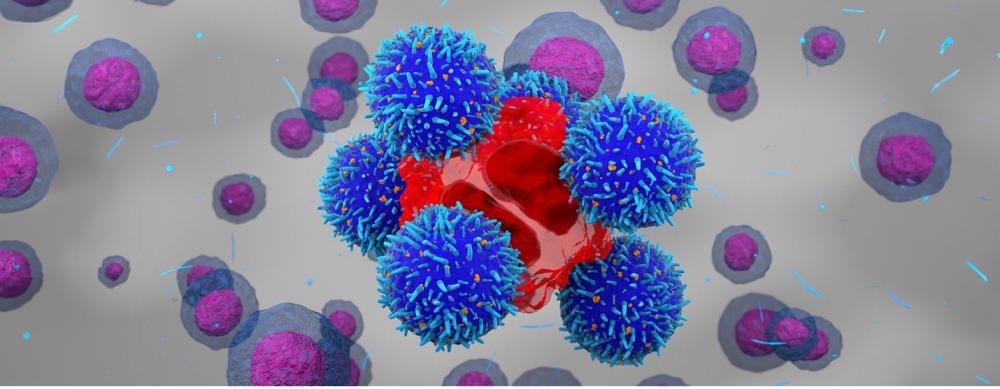
Research
Main navigation
Research

Grand MMTI - Research
Multiple myeloma (MM) is the second most common hematologic malignancy among adults, with approximately 35,000 new cases diagnosed per year in the United States. It is a complex disease with diverse and distinct subtypes that can affect outcomes and responses, and despite the tremendous progress in MM treatment in recent decades there is no known cure. Improving outcomes for MM patients requires a multi-pronged approach that both identifies new treatments as well as improve upon existing ones, addressing the high-risk myeloma and extramedullary subtypes of the disease, and monitoring disease progression effectively to enhance decision-making and therapy adjustments. As a result, the Grand MMTI Research is focused in 4 fundamental areas of multiple myeloma treatment:
- Novel Immunotherapy approaches
- Monitoring response
- Detection/theranostics
- Identifying and Managing Toxicities

Novel Immunotherapy Approaches
A priority for MMTI research is expanding and optimizing the use of immunotherapy for multiple myeloma (MM) treatment, with a particular focus on cellular therapies, such as chimeric antigen receptor expressing T-cells (CAR-T). These therapies are showing great promise in the clinic, and it is believed that with additional research these therapies could ultimately lead to long-term remissions or even cures. Our first chimeric antigen receptor product is a BMCA CAR T-cell therapy (UCCT-BCMA1) that, based on the work of Justin Eyquem, PhD, Alex Marson, MD, PhD, Brian Shy, MD, PhD and Michel Sadelain, MD, PhD (at Memorial Sloan Kettering Cancer Center), holds significant promise for improved potency and better durability for patients.
In addition to an updated and improved design, UCCT-BCMA1 is generated using non-viral CRISPR/cas9-based gene editing approaches which more precisely edit cells and result in healthier cells with longer persistence. cGMP manufacturing of CRISPR/cas9-generated cellular therapies for clinical use is in its very early stages as a field and spearheading that process for the MMTI is Dr. Shy. As a result of his work, UCCT-BCMA1 is anticipated to enter clinic evaluation in 2025. Once finalized, Dr. Shy intends to make these CRISPR-Cas9 manufacturing processes open source in order to inform other cellular therapy groups and help them move their products more quickly and at lower cost through GMP manufacturing development and into the clinic.
While BCMA-targeting CAR-Ts have vastly improved options for many myeloma patients, those patients with high-risk myeloma tumor genotypes typically do not experience the same benefit from and relapse more rapidly after BCMA CAR-T treatment. Additionally, patients failing BCMA CAR-T therapy currently have very poor outcomes and no clear next line of treatment. As a result, there remains a strong need to identify new and effective cellular therapy targets to complement BCMA, particularly in patients with high-risk disease. Dr. Arun Wiita’s group have discovered that CD70 is a promising MM immunotherapeutic target that appears to be upregulated in high-risk myeloma genomic subtypes. They have engineered a novel, potent CAR T-cell therapy that has shown very favorable efficacy in models of multiple myeloma and are now optimizing the therapy towards final clinical candidate selection.
Even as we hope that the outcomes from the UCCT-BCMA1 trial and the future CD70 CAR-T cell therapy trials will result in improved CAR T-cell therapies for our patients, we do not expect that these approaches will solve all the CAR T-cell therapy issues. We know that getting to a cure still requires a lot of work. We have built our program to maximize learnings so that our clinical experience with CAR-T therapies informs our research developments and our fundamental research developments inform our clinical practice.
Monitoring response and driving decision-making

Monitoring patient response to therapies at a molecular level thus anticipating future disease behavior can be a powerful tool for managing a patient’s treatment course. Jeffrey Wolf, MD, and colleagues have been evaluating the use of minimal residual disease (MRD) monitoring as one such tool. MRD is a term used to describe the small number of cancer cells that remain in the body after treatment. These cells can potentially come back and cause a relapse of the disease.
Patients who are MRD positive still have detectable numbers of cancer cells their system, whereas those patients that are MRD negative do not. Dr. Wolf’s research has been quantifying and validating the use of MRD in both clinical trials and patient treatment to help with earlier determination of treatment efficacy and for improving treatment course, including whether certain patients can go off treatment entirely.
MM Detection/Theranostics

Theranostics are an emerging class of therapeutics showing promise for precision cancer treatment. The term “theranostics” comes from the terms therapeutics and diagnostics and is used to describe drugs that can both identify (diagnose) tumors using an imaging agent and treat tumors with radiopharmaceutical therapy. Given their precision in targeting tumors, theranostics are able to reduce the risk of side effects to nearby healthy tissues.
Robert Flavell, MD, has been examining the use of theranostics for multiple myeloma. Utilizing the target CD46, identified by UCSF faculty as over-expressed in multiple myeloma cells, Dr. Flavell has generated both imaging agents and therapeutic agents. His research showed that the CD46-targeted agents can both successfully image and inhibit cancer growth in MM mouse models. Currently, the CD46 imaging agent ([89Zr]DFO-YS5) is in clinical evaluation as an imaging agent for multiple myeloma
Identifying and Managing Toxicities

Post-CAR-T Neurotoxicity
Subacute to late neurological toxicities have been observed after CAR-T administration, including a Parkinson-like syndrome, cranial nerve palsy, peripheral neuropathy, and Guillain Barré syndrome. These toxicities can be associated with significant morbidity but given their relative rarity in clinical trials, there is limited data regarding evaluation and treatment. UCSF, under the leadership of Anupama Kumar, MD, is leading efforts to create a global registry of these cases to better understand which patients are most susceptible to these toxicities and how to manage and prevent these toxicities.